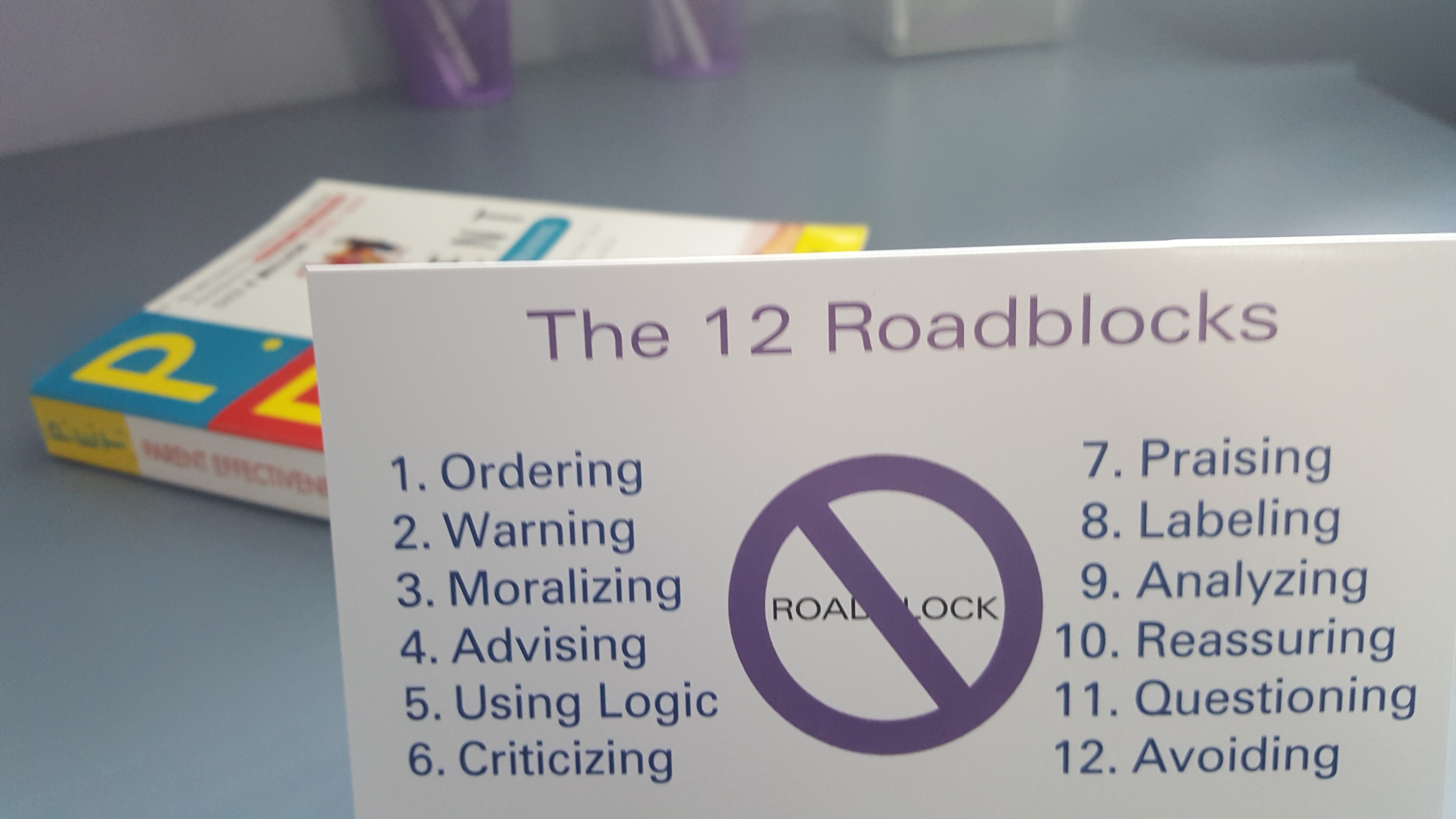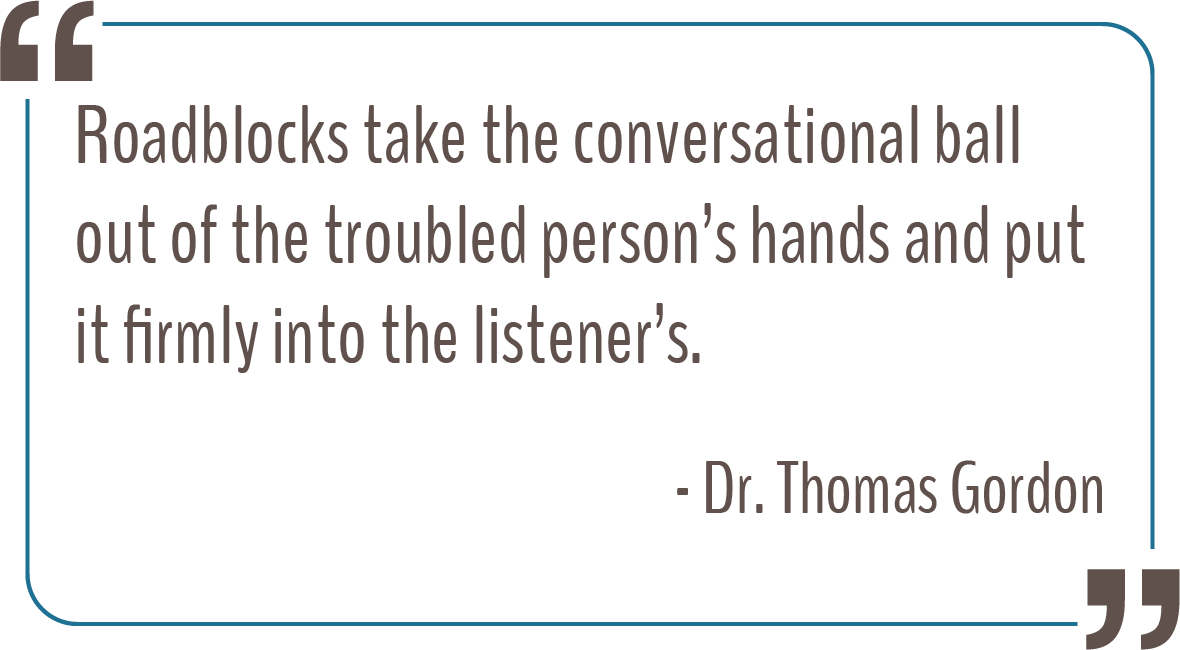By: Dr. Thomas Gordon (excerpted from the P.E.T. Participant Workbook, 2017 edition)
Throughout our lives, we have learned a variety of ways to help children as well as adults when they have strong feelings, thoughts or problems. We want to be helpful, yet many of our responses actually make it more difficult for the person to express himself, make a decision or solve a problem.
Listed here are twelve of the more frequent “helping responses” which can become “Roadblocks” to communication. When you read this list, you may feel like the rug has been pulled out from under you because so many of your regular ways of talking are now called roadblocks.
Two things to know about “Roadblocks”.
- These are roadblocks when the child is experiencing a problem or strong feelings (“Child Owns a Problem”). When the relationship is in the “No Problem Area”, many of these are not blocks (e.g. joking, asking questions, etc.). Some, like name-calling and ridiculing are always risky and cause problems.
- You are not a “bad” parent because you use roadblocks. You are doing what you have been taught to do to help others. P.E.T. will provide you with more effective alternatives to begin using instead of these common roadblocks.
1. ORDERING, DIRECTING
“Stop feeling sorry for yourself …”
• Communicates unacceptance or low evaluation of child
• Takes responsibility away from child
• Can cause resistance, contrary behavior
2. WARNING, THREATENING
“You’ll never make friends if…”
“You’d better stop worrying so much or…”
• Communicates unacceptance
• Can produce fear, submissiveness
• Invites “testing” of threatened consequences
• Can cause resentment, anger, alienation
3. MORALIZING, PREACHING
“Life is not supposed to be easy …”
“You shouldn’t feel that way…”
“Patience is a virtue you should learn…”
• Creates “obligation” or guilt feelings
• Can cause child to “dig in” and defend his or her position even more (“Who says?”)
• Leads to withdrawal, alienation, or to counter moralizing. (“Well, you shouldn’t . . . either!”)
4. ADVISING, GIVING SOLUTIONS
“What I would do is…”
“Why don’t you…”
“Let me suggest…”
• Can imply child is not able to solve own problems
• Prevents child from thinking through a problem, considering alternative solutions, and trying them out for reality
• Can cause dependency, or resistance
5. PERSUADING WITH LOGIC, ARGUING
“Here is why you are wrong…”
“The facts are …”
“Yes, but…”
• Provokes defensive position and counter arguments
• Often causes child to “turn off” parent, to quit listening
• Can cause child to feel inferior, inadequate
6. JUDGING, CRITICIZING, BLAMING
“You are not thinking maturely …”
“You are just lazy…”
“Maybe you started the fight first …”
• Implies incompetency, stupidity, poor judgment
• Cuts off communication from the child over fear of negative judgment or “bawling out”
• Child often accepts judgments as true (“I am bad”), or retaliates (“You’re not so great yourself!”)
7. PRAISING, AGREEING
“Well, I think you’re doing a great job!”
“You’re right! — that teacher sounds awful!”
• Implies high parental expectations and possible future evaluation
• Can be seen as patronizing or as a manipulative effort to encourage desired behavior
• Can cause anxiety when child’s perception of self doesn’t match parent’s praise
8. NAME-CALLING, RIDICULING
“Crybaby…”
“That’s stupid to worry about one low test grade.”
• Can cause child to feel unworthy, unloved
• Can have devastating effect on self-image of child
• Often provokes verbal retaliation
9. ANALYZING, DIAGNOSING
“What’s wrong with you is…”
“You’re just tired.”
“What you really mean is…”
• Can be threatening and frustrating
• Child can feel either trapped, exposed, or not believed
• Stops child from communicating for fear of distortion or exposure
10. REASSURING, SYMPATHIZING
“Don’t worry.”
“You’ll feel better.”
“Oh, cheer up!”
• Causes child to feel misunderstood
• Evokes strong feelings of hostility. (“That’s easy for you to say!”)
• Child often picks up parent’s message as “It’s not alright for you to feel bad “
11. PROBING AND QUESTIONING
“Why…?”
“Who…?”
“What did you…?”“
“How…?”
• Since answering questions often results in getting subsequent criticisms or solutions, children often learn to reply with non-answers, avoidance, half-truths, or lies
• Since questions often keep the child in the dark as to what the parent is driving at, the child may become anxious and fearful
• Child can lose sight of his or her problem while answering questions spawned by the parent’s concerns
12. DIVERTING, SARCASM, WITHDRAWAL
“Let’s talk about more fun stuff…”
“Why don’t you try running the world!”
Remaining silent; turning away.
• Implies that life’s difficulties are to be avoided rather than dealt with
• Can infer child’s problems are unimportant, petty or invalid
• Stops openness from child when he is experiencing a difficulty

